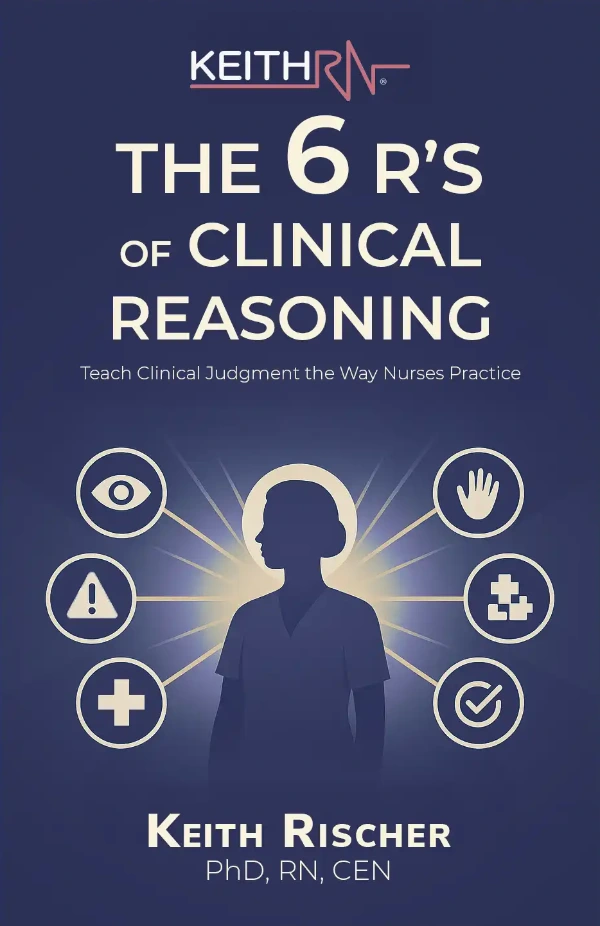
In order to transform nursing education, classroom content must be contextualized to the clinical setting (Benner, Sutphen, Leonard, & Day, 2010).
If nurse educators do not contextualize content to the bedside, lectures can digress to simply regurgitating what is already in the textbook that students are able to read.
I would like to share eight essential components that every classroom lecture must address so that students are able to readily transfer classroom learning to the bedside where it matters most!
My Story
When I began to do things differently in my classroom after reading Educating Nurses: A Call for Radical Transformation, I realized that something had to give. My content heavy lectures with minimal application were cut in half in order to make time for active learning.
I would like to share eight essential components to help guide nurse educators HOW to emphasize NEED to know content to transfer learning to the bedside!
The eight components include:
- Pathophysiology review
- Most important medications
- Most important labs
- Nursing priorities and plan of care
- Worst possible and most likely complications
- Nursing assessments to identify these complications
- Interventions needed to rescue From a Change of Status
- Patient education priorities
1. Pathophysiology review
Just because pathophysiology was covered as a prerequisite is no reason not to cover it again in class, but keep it short and simple. Make sure that students understand the complex physiology of some of the topics/concepts that are taught in your classroom.
Memorizing content to pass a test is not the same as understanding and applying content.
For example, the difference between right vs. left side vs. bi-ventricular heart failure and WHY patients typically develop SOB and orthopnea (left sided) BEFORE fluid retention and pitting edema are present in the lower extremities (right sided) is an excellent example of the importance of applied pathophysiology to practice.
When pathophysiology is deeply understood, the critical thinking of the nurse dramatically improves as well.
2. Most important medications
Highlight and identify the most commonly used medications to address the problem or concept you are teaching and why they are given. In addition to reviewing the medications, briefly highlight the mechanism of action.
This is the most important content for any student to know and UNDERSTAND to safely administer a medication.
This also reinforces the importance of pathophysiology to practice.
When both pathophysiology and the mechanism of action are deeply and clearly understood, commonly used medications such as lisinopril and furosemide with heart failure are readily understood and the rationale for administration and how it will benefit the patient.
3. Most important labs
Identify the specific labs in any given panel and not the entire panel relevant to your concept or topic. For example, in a basic metabolic panel, for most patients including those in heart failure, the most important and RELEVANT labs include sodium, potassium, and creatinine.
Make sure that your students understand why sodium, potassium, and creatinine are relevant to every patient! When the physiology of fluids and electrolytes is readily understood, students will be able to recognize relevant clinical data which is an essential component of clinical reasoning.
4. Nursing priorities and plan of care
Identifying all priorities including nursing priorities is also an essential component of clinical reasoning. Though NANDA has been the taxonomy that has been used for over three decades to identify nursing priorities in academia, NANDA has limitations to practice and students must be able to clearly state the nursing priority and not always be held hostage to NANDA! (see prior blog Why NANDA is a NONO)
Though beginning or fundamental students should adhere more closely to this taxonomy, give your advanced students flexibility and freedom to simply state the priority as it fits for their patient. This is what nurses in practice do, so do the same for your advanced students!
5. Worst possible and most likely complications
Every patient can gradually or quickly change status and deteriorate with a complication. Sepsis is an excellent example of this slow fade that can be deadly if it is not recognized EARLY.
Make it a priority to identify these complications in your lecture so students can transfer this learning to the clinical setting.
For example in heart failure, pulmonary edema would be a possible complication especially if they are early in their admission. Deep vein thrombosis is also a potential problem for any patient who is immobile.
6. Nursing assessments to identify these complications
Once the most common complications are identified, what assessments are needed by the nurse to quickly identify this problem EARLY and not later. In the patient with heart failure, early signs of pulmonary edema would be tachypnea, lack of tolerance to activity, and increasing oxygen needs. Once the patient is in respiratory distress with decreasing O2 sats, this is too late and could lead to an adverse outcome!
7. Interventions needed to rescue with status change
Once a problem has been identified EARLY, what will the nurse then do about it? This proactive thinking must be identified in the classroom so students can transfer this to the clinical setting.
This is a care plan within a care plan based on the need to rescue.
Since failure to rescue is an ongoing problem in health care, it is essential that students are taught to develop a secondary plan of care based on the most likely or common complication.
When the nurse is caught flat-footed in practice by not anticipating or being prepared when a problem develops, this will ultimately affect the patient and can lead to adverse outcomes including patient death.
8. Patient education priorities
The professional nurse is also an educator. Students tend to minimize or not make this a priority because they are a student learner and feel incapable of teaching patients.
Push your students out of the nest at the very beginning by identifying patient education priorities so that patients are empowered with needed knowledge when they have a chronic problem.
By identifying patient education prioirities and then teaching it, students can see how nursing partners with the patient to achieve beneficial outcomes.
In Closing
In order to transform nursing education, clinical must come to class by situating clinical realities into the classroom (Benner, Sutphen, Leonard, & Day, 2010).
Emphasize what is most important so students acquire a deep learning of what content is MOST important so it can be transferred to the bedside.
By integrating and implementing these eight components in every classroom lecture, you can be confident that you are addressing what is most important so that your students will be well prepared for clinical practice!
What do you think?
What have you done to strengthen student learning in your classroom?
Comment below and let the conversation begin!References
Benner, P., Sutphen, M., Leonard, V., & Day, L. (2010). Educating nurses: A call for radical transformation. San Francisco, CA: Jossey-Bass.
Keith Rischer – PhD, RN, CEN
As a nurse with over 35 years of experience who remained in practice as an educator, I’ve witnessed the gap between how nursing is taught and how it is practiced, and I decided to do something about it! Read more…
The Ultimate Solution to Develop Clinical Judgment Skills
KeithRN’s Think Like a Nurse Membership
Access exclusive active learning resources for faculty and students, including KeithRN Case Studies, making it your go-to resource.




